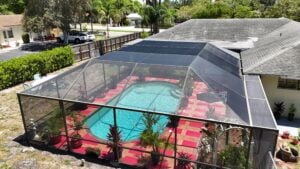Call: (877) 690-0072
The Ultimate Guide to Patio Screen Selection: Protecting Your Outdoor Space Year-Round
The patio is more than just a spot to unwind—it’s a vital part of your home’s living space. Whether you’re enjoying a sunny brunch, hosting a backyard barbecue, or sipping coffee at sunrise, your patio should offer both comfort and protection.
In this ultimate guide, we’ll walk you through everything you need to know about choosing the right patio screen to keep your outdoor area safe from environmental damage. From harsh sun and heavy rain to bugs and debris, the elements can wear down even the toughest screens—unless you pick the right materials and features for your climate.
Here’s what we’ll cover:
Common factors that damage patio screens
How to select the best screen material for your region
Features to look for to ensure durability, comfort, and year-round usability
Let’s get started—and turn your patio into a space that lasts.
Your patio screen is constantly exposed to the elements. While it offers protection, it’s also vulnerable to a variety of environmental and mechanical stressors. Here’s a deeper look into what can lead to damage over time:
Prolonged exposure to direct sunlight can be extremely damaging to most screen materials. UV rays cause the mesh to become brittle, fade in color, and eventually tear. In high-sunlight areas like Arizona, Nevada, or Southern California, screens without UV protection may last only a few years before needing replacement. Moreover, UV damage isn’t just cosmetic—it compromises the screen’s ability to shield you from insects and debris.
Tip: Use solar screens or screens with UV inhibitors if your patio gets intense daily sunlight.
Strong gusts of wind can pull mesh from the frame, bend structural supports, or cause screens to flap violently—leading to rips or permanent distortion. In hurricane-prone areas like Florida or the Gulf Coast, a poorly installed or lightweight screen won’t last a season. Wind-blown debris such as twigs, leaves, or even trash can puncture or scratch the screen as well.
Tip: Reinforced aluminum frames and high-tension screen fabrics help withstand stormy conditions.
High humidity or frequent rainfall can cause mold, mildew, and frame corrosion—especially in areas near the coast or in tropical climates. If your screen is not mildew-resistant, black spots and foul odors can develop quickly. Moisture trapped in mesh or framing can also lead to rust, weakening the structural integrity of your screen system.
Tip: Choose rust-proof materials like fiberglass or polyester with mildew-resistant coatings, and avoid untreated metal frames.
Tiny insects like gnats, mosquitoes, and no-see-ums can slip through coarse or damaged mesh. Pests can also chew on mesh fibers—especially rodents, squirrels, or raccoons, which are drawn to patios with food remnants. If you live in bug-heavy areas, like swampy or forested regions, a basic mesh screen won’t be enough.
Tip: Use tightly woven mesh (20×20 or finer) specifically designed to keep even the smallest insects out.
In dry and windy regions—such as deserts or plains—fine sand and dust particles can clog mesh openings, scratch the surface, and lead to discoloration. Over time, buildup can also make your screen look dirty and block visibility.
Tip: Easy-to-clean, dust-resistant screens work best in dry climates. Use a hose or soft brush for routine maintenance.
Snow and ice can put a heavy load on screens and cause materials to crack or warp—especially if the mesh absorbs water and then freezes. Metal components may become brittle in cold weather, leading to stress fractures or corrosion from salt used on nearby walkways.
Tip: Select screens with flexible, cold-resistant mesh and insulated or powder-coated framing for snowy climates.
Choosing the right screen based on your local climate is key to maximizing protection and longevity. In this ultimate guide, we break down the best screen options for each major climate zone:
Regions: Florida, Gulf Coast, Tornado Alley (Texas, Oklahoma)
Common Issues: Wind gusts, flying debris, structural damage
Best Screen Type:

Why: These screens resist tearing and hold strong during strong winds or even hurricanes. Look for screens rated for high wind loads.
Regions: Florida Keys, Louisiana, Hawaii, Pacific Northwest
Common Issues: Mold, mildew, rust, corrosion
Best Screen Type:
Why: These materials resist rust and moisture damage, essential for long-term use near water. They’re also easy to clean and less prone to bacteria buildup.
Regions: Arizona, Nevada, Southern California, Texas
Common Issues: UV damage, furniture fading, glare
Best Screen Type:
Why: Solar screens help block harmful rays, reduce glare, and keep your patio cooler during peak summer heat. They also prevent patio furniture from fading and protect skin from prolonged sun exposure.
Regions: Midwest, Northeast, Mountain States
Common Issues: Snow load, freezing damage, cracking
Best Screen Type:
Why: Flexible mesh won’t crack under cold stress, and powder-coated frames prevent rust. Retractable screens can be closed during extreme winters to extend lifespan.
Regions: New Mexico, Utah, parts of California
Common Issues: Dust storms, sand abrasion, mesh clogging
Best Screen Type:
Why: Fine mesh keeps dust out while still allowing airflow. Anti-static coatings help repel dust particles, keeping screens cleaner longer.
Don’t let unpredictable weather ruin your patio experience. In this ultimate guide, you’ll learn how to identify the factors that can damage patio screens and how to choose materials tailored to your region—so you can enjoy a more comfortable, cleaner, and longer-lasting outdoor space.
Whether you’re facing harsh sun, salty air, freezing cold, or swarming bugs, the right patio screen makes all the difference.
Explore climate-smart screen solutions at PatioScreenPro.com — your trusted source for high-performance, durable patio screens built for every environment.
#PatioScreenRepair
#BocaRatonOutdoorLiving
#PembrokeScreenReplacement
#FloridaLanaiRepair
#MosquitoFreePatio
#RescreeningExperts
#PatioScreenPro
#UVDamageScreenFix
#LicensedFloridaContractors
#SouthFloridaScreenEnclosures